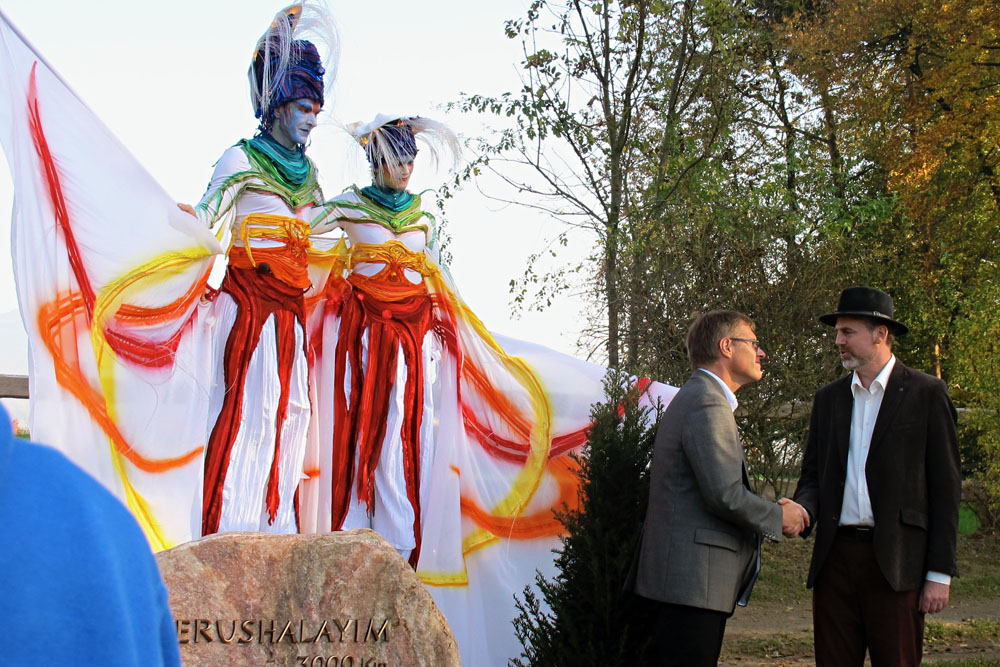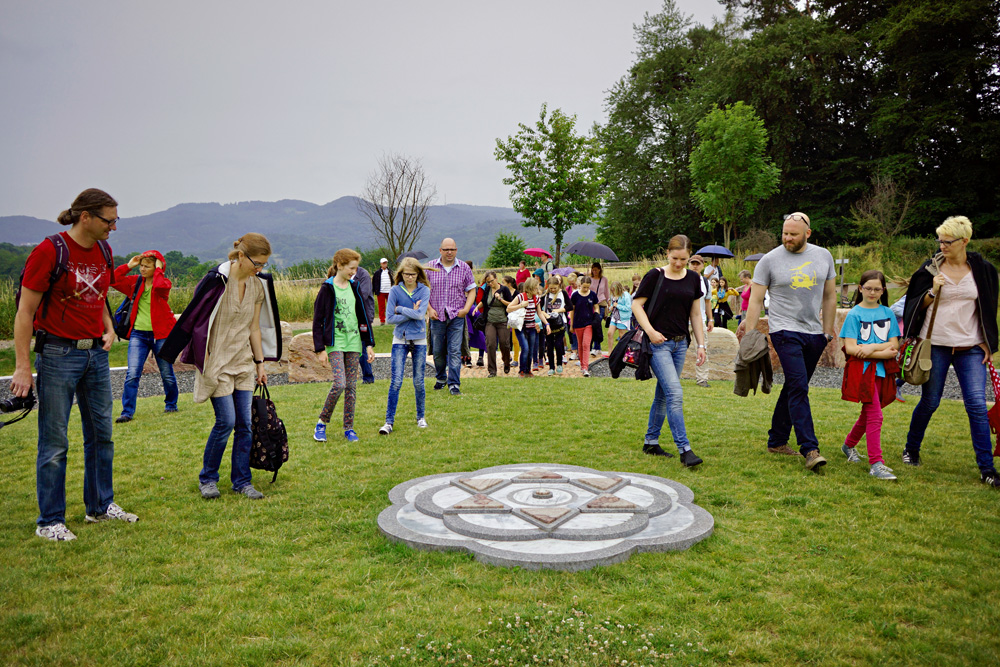The Israeli artist Dganit Daddo sings at the Friedensmal with students from Haifa during the inauguration ceremony in Bensheim-Hochstädten.
Chapter: Procekt / Heritage and Identity
Introduction In the chapter 'Heritage and Identity', we embark on a profound journey through the themes of responsibility, encouragement, cultural heritage, healing, and freedom. We take a look at Germany's past, present, and future and explore how these principles are interwoven. Special attention is given to the white 'Blossom of Life' as a symbol of purity and spirituality, which stands at the center of the Friedensmal. It is not just a random reminder of another white flower, the 'White Rose'. This chapter lays the foundation for our understanding of the subsequent chapters and shows how important it is to be vigilant against collective delusion and totalitarian developments. It emphasizes the importance of freedom and self-responsibility and raises the question of how we, as a society and individuals, can stand up for these values.
A white Blossom - Out of Responsibility for Peace and Freedom
The inclination towards collectivism, envy, and subservience in the first half of the 20th century in Germany created fertile ground for anti-Semitism and totalitarian currents (
see reviews). This historical reflection reminds us of the importance of remaining vigilant against any collective delusion and totalitarian developments. Human dignity is based on the freedom to live responsibly and uprightly. These values of freedom must be actively defended and lived, otherwise, they risk being lost.
The artist Thomas Zieringer gives a lecture at a community gathering. Mayoral candidates were also present.
At the center of the Friedensmal lies a white blossom. This may remind us of the 'White Rose' of the Scholl siblings. Their courage to take responsibility out of deep faith is a timeless example of what it means to stand up for peace and freedom. This symbolism encourages us to embark on our own path towards maturity and responsibility. Peace and Shalom are possible when we, individually and as a community, commit ourselves to these values.
Silence, beauty, and the hope for true freedom: a great message for our time
This chapter deepens the understanding of the subtle aspects of peace and freedom. It emphasizes the importance of silence and inner reflection as ways to experience true beauty and healing. In quietness lies the power to hear the soft voices of the heart and to appreciate the fine details of life that often get lost in the noise of everyday life.
The Friedensmal stands as a place of silence and contemplation. It invites one to be touched by beauty and to embark on a path of healing. In a world often dominated by the combating of negative aspects, the perception and appreciation of the good should become even more important – especially that good which happens in small and quiet ways. The focus is not on loud grandiosity, but on subtle beauty. The noise of our time can deafen us to the quiet tones of life, which point us to what is essential. With the inscription 'Yerushalayim' on the Stone of Encounter, the memorial carries a meaningful name, inviting reflection on true greatness – a greatness that lies in simplicity and in detail. In silence and careful observation, a new understanding of freedom can arise – an essential hope for our times.

The farewell at the Stone of Encounter symbolizes what Yerushalayim can mean: a togetherness in which no one elevates themselves above the other. We express our thanks to
The Beauty of Life and the Dignity of Man
This chapter introduces German culture and its light and shadow sides. It emphasizes the importance of valuing and preserving cultural heritage while simultaneously finding a healthy balance between change and tradition.German culture has much light. So many cities are wonderful. Philosophy, poetry, and science speak for themselves. The prosperity of today's generation rests on a cultural foundation that previous generations have built with much effort and also through much suffering. Without appreciation, without the will to preserve the light of one's own culture through the changes of time, our country would first lose its soul and then its wealth. The understanding that life always means change and the mindfulness to preserve the light of one's own culture must find a healthy balance.
However, every culture brings with it a shadow that must be recognized. The pressure to conform in our country is high to align one's thoughts with a majority opinion. Those who do not agree with the prevailing ideology in the "collective of the good" are often considered indecent and excluded. There is no broad public discussion about differing opinions. Without a corrective, the German nation repeatedly falls into (self-)destructive ideas. Once upon a time, the world was supposed to heal through German essence. Today, salvation is sought in the dissolution of one's own cultural identity, and thus the cultural foundation of our society erodes. There is no measure and no middle ground. But this can only happen because, on an individual level, people in our country are already so ashamed to look at their own shadows. Yet that would simply be human;

The Blossom of Shalom at the center of the Friedensmal stands as a heart symbol for the person connected to life.
The Importance of Healing Our Cultural Roots
Healing cultural roots is a universal concern. Every society has its own history and its own challenges. Just as German culture today requires an impulse for healing its historical wounds, so too do many other cultures around the world. The process of recognition and healing is crucial to develop a deeper understanding and a stronger connection to one’s own cultural roots. This fosters an awareness that supports freedom and mutual respect in the global community.
Just as a tree needs healthy roots to stretch its branches towards the sky, so it is with a culture. It has its foundation, it has its roots. Particularly today, German culture needs the impulse of healing its own roots, as this project aims to convey. This reveals that freedom can only spring from an inner awareness that understands the foundations of one’s own culture and thus can give the human spirit confidence and protection to discover the heavens.
Therefore, it requires the recognition of the roots of one's own culture, especially in German culture the root of 'Jerusalem', and healing in this relationship. This brings to the fore the deepest trauma of the German nation: the murder of the Jews and thus the destruction of its own cultural and spiritual foundation. The topic thus becomes healing in the German-Jewish relationship, the realization of a new Shalom where it is most deeply needed. In this way, lessons would actually be learned from both German and Jewish history: that one is willing to courageously stand up for freedom – especially the freedom of others.

Dust to Light - Healing Emotional Wounds
This chapter delves into the concept of healing and reconciliation. It discusses how ignorance, self-righteousness, and envy can be overcome to create a better and more healed world. It emphasizes the importance of freedom in the context of peace and understanding.This is a place that stands for the beauty of life and the dignity of the human being. Here, people can become more aware of their inner longing for sanctity: How can the healing of emotional wounds be experienced in one's own life? How can this longing be carried into society? A "better world," a more healed world, can become possible when ignorance, self-righteousness, and envy in relationships give way to genuine interaction with one another. The inscription "Wo sich Staub zu Licht wandelt" ("Where dust turns to light") under the
Stone of Encounter signifies a hopeful vision of coexistence and means that free people seek peace, reconciliation, and an understanding of themselves and others. This place—the Friedensmal framed by the Garden of Freedom, with the Stone of Encounter along the path—is a symbol of this idea. It establishes a connection to the hearts of people, where dust turns to light.You can learn more about the spiritual background of this project in this elaboration on Nelly Sachs, featuring some of her poems and some interesting philosophy.
View of the Rhine Plain with Worms on the Horizon. This city was part of the former Jerusalem on the Rhine.
Conclusion
In light of these insights and the journey through various facets of responsibility, encouragement, cultural heritage, healing, and freedom, an important message emerges: The true path to freedom and peace lies in the recognition of our cultural roots, the healing of our emotional wounds, and the responsibility for a better world.
The insights we gain from German history, with its dark shadows and shining moments, are universal lessons. They show us how crucial it is to stand up for the freedom and dignity of all people, regardless of their origins or cultural background. Our cultural roots, symbolized here by Jerusalem, offer us valuable insights into the meaning of freedom and responsibility – insights that have global validity.
The vision of coexistence, where 'dust turns to light,' is a universal hope. It is the task of each individual to overcome prejudice and narrow-mindedness and to commit to true freedom, peace, and understanding. The Friedensmal, as a symbol of these ideals, represents the endeavor of many people worldwide to work towards a better world.
Let us therefore learn from the past and courageously stand up for the well-being of all people. Together, we can work towards a world where peace, freedom, and healing are not just possible, but a reality.
